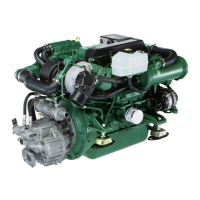58
Cooling system
The engines are fresh-water cooled and have a sea-
water-cooled heat exchanger. In the fresh-water sys-
tem fresh-water fluid is pumped around by a gear driv-
en circulation pump.The sea water from the heat ex-
changer goes out through the exhaust system (wet
exhaust line).
The installer of the cooling system is responsible for
ensuring that the cooling system operates in accor-
dance with these installation instructions.
The cooling system must be dimensioned generously
enough to ensure that fouling and repainting do not ad-
versely affect its cooling performance even after a
long period of service.
The pipe and hose diameters stated in these installa-
tion instructions are to be treated as recommenda-
tions. The only way to tell whether an installation is
correct is to check pressures, temperatures and flows
with the engine running. In case of doubt, contact the
Volvo Penta organisation.
Carefully plan where the fittings are to be placed so
that they are accessible. The lines should be arranged
so that they are as short as possible.
To reduce corrosion to a miniumum, use the correct
combinations of materials in pipes, valves etc. plus a
correctly sized and pressurized expansion tank. Elec-
trolytic corrosion may occur when two different materi-
als surfaces are in contact with each other and placed
in an electrolyte such as moisture or seawater.
Use genuine Volvo Penta accessories and spare parts
wherever possible. Accessories are described in
Vol-
vo Penta Accessories & Maintenace Parts.
Make
sure that parts not supplied by Volvo Penta do not re-
strict or reduce pressures and flow in the engine.
Lines with an excessively small bore, unsuitable rout-
ing, incorrect connections etc will cause restrictions
and lead to abnormal engine temperatures.
Always use Volvo Penta coolant in a mixture of anti-
freeze or anti-corrosion agent. The coolant used af-
fects the cooling performance and corrosion protection
of the engine.

